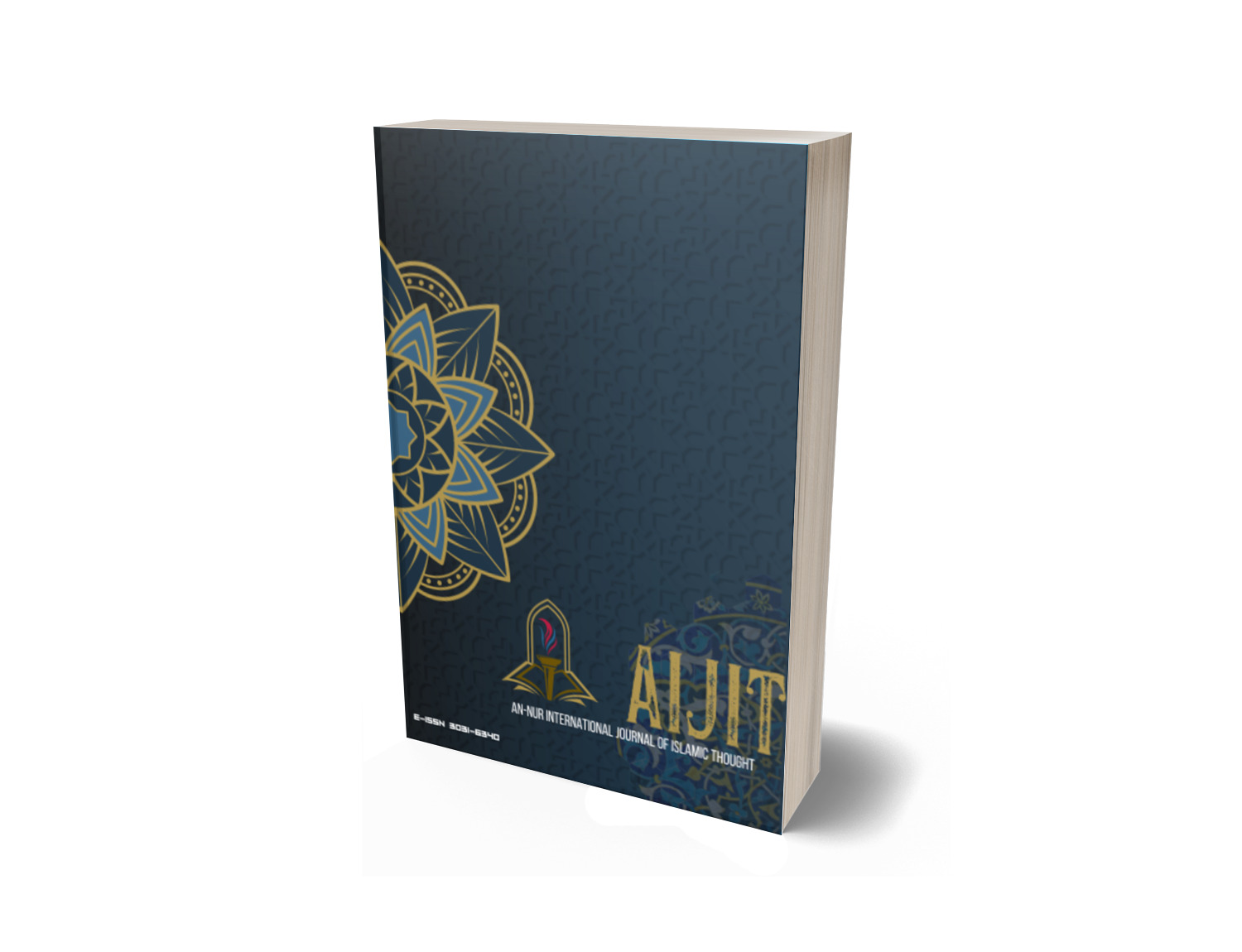Between the Sword and the Soul: Sufism’s Living Tradition of Jihād
Keywords:
Sufism, Jihād, Spiritual struggle, Sufi militancy, Salafi-jihadismAbstract
This article explores the multidimensional understanding of jihād within the Sufi tradition, focusing on its typology as internal, verbal, and physical struggle (jihād al-nafs, jihād al-lisān, jihād al-Sayf). Drawing on classical Sufi texts, historical accounts, and modern scholarly analyses, the study re-evaluates the perception of Sufism as an exclusively pacifist movement. It argues that early Sufi thinkers such as Al-Ghazālī, Rūmī, and ʿAbdallāh b. al-Mubārak developed an integrated conception of jihād that prioritized spiritual purification but also permitted martial engagement under ethical conditions. The paper highlights the roles of Sufi saints and brotherhoods in resisting tyranny through speech, participating in holy wars, and supporting imperial military structures such as the Janissaries and Mughal armies. In modern times, many Sufi groups have reinterpreted jihād in nonviolent, ethical, and social terms, offering a counterbalance to Salafi-jihadist ideologies. The study concludes that Sufism’s legacy of combining inner discipline with outward responsibility provides a more holistic and historically grounded vision of jihād, one that continues to resonate in contemporary Islamic thought and global religious discourse.
Downloads
References
Aini, I., & Hariyanto, H. (2020). Analytic Study in the “Sufi Comic Book 3” About the Concept of Self Purification in Islamic Education. EDUCAN: Jurnal Pendidikan Islam, 4, 31–48. https://doi.org/10.21111/EDUCAN.V4I1.3990
Akhlaq, S. H. (2023). Handbook of Islamic Sects and Movements. Islam and Christian–Muslim Relations, 34(1), 101–103. https://doi.org/10.1080/09596410.2023.2167679
Al-Ghazālī, Z. al-D. A. H. M. ibn M. ibn M. ibn A. (2011). Iḥyāʼ ʻulūm al-dīn. Dār al-Minhāj lil-Nashr wa-al-Tawzīʻ.
al-ʻArabī, I., & Ghurāb, M. M. (1981). al-Insān al-kāmil ; wa al-Quṭb al-Ghawth al-Fard. Maṭbaʻat Zayd ibn Thābit.
Al-Kaisi, M. (2021). Rethinking Conceptual Sufism: A Synthesis of Islamic Spirituality, Asceticism, and Mysticism. Teosofi Jurnal Tasawuf Dan Pemikiran Islam, 11(2), 169–193. https://doi.org/10.15642/teosofi.2021.11.2.169-193
Aljunied, K. (2024). Sufi Warriorism in Muslim Southeast Asia. Sociology Lens. https://doi.org/10.1111/johs.12474
Amiri, A., & Daneshshahraki, H. (2024). The Epistemological Foundations of Jihad Based on the Theory of Human Nature by Ayatollah Shahabadi. International Journal of Multicultural and Multireligious Understanding. https://doi.org/10.18415/ijmmu.v11i2.5560
Anbiya, A. Z. (2023). Tazkiyatun Nafs dalam Mengembalikan Fitrah Manusia Modern. Islamic Counseling: Jurnal Bimbingan Konseling Islam. https://doi.org/10.29240/jbk.v7i1.5130
Andon, P., Free, C., Radcliffe, V. S., & Stein, M. (2022). Boundary Work at the Margins of Politics and Auditing: Rationalising Advertising Probity in Ontario. Accounting Auditing & Accountability Journal, 35(8), 1830–1861. https://doi.org/10.1108/aaaj-06-2020-4641
Buehler, A. (1998). Sufi Heirs of the Prophet: The Indian Naqshbandiyya and the Rise of the Mediating Sufi Shaykh. University of South Carolina Press.
Burak-Adlı, F. (2024). The Portrait of an Alla Franca Shaykh: Sufism, Modernity, and Class in Turkey. International Journal Middle East Studies, 56(2), 207–226. https://doi.org/10.1017/s0020743824000631
Burney Abbas, S. (2007). Risky Knowledge in Risky Times: Political Discourses of Qawwālī and Sūfīana‐kalam in Pakistan‐Indian Sufism. The Muslim World, 97(4), 626–639. https://doi.org/10.1111/j.1478-1913.2007.00204.x
Chalisova, N. Y. (2019). Interpreting the term nafs: a component of the Sufi doctrine. Orientalistica. https://doi.org/10.31696/2618-7043-2019-2-2-421-434
Cook, D. (2005). Understanding Jihad. University of California Press.
Digby, S. (2001). Sufis and Soldiers in Awrangzeb’s Deccan. Oxford University Press.
Faruqi, D. (2023). 19th Century Moroccan Sufism and the 2011 Syrian Revolution: The Legacy of Shaykh Muḥammad ibn Mas’ūd al-Fāsī. Journal of Islamic and Muslim Studies, 8(1), 1–35. https://doi.org/10.2979/jims.00002
Febriani, S. (2025). Kerangka Pemikiran Intelektual Islam Sultan Mahmud Badaruddin II Di Kesultanan Palembang Darussalam (1803–1821). The International Journal of Pegon Islam Nusantara Civilization, 14(01), 35–86. https://doi.org/10.51925/inc.v14i01.128
Fouad, H. (2020). Unveiling the Innovators—A Glimpse on Sufi-Salafi Polemics. Religions, 11(3), 144. https://doi.org/10.3390/rel11030144
Geaves, R. (2013). ‘That Which We Have Forgotten’: The Emergence of ‘Traditional Islam’ as a New Movement in Global Muslim Religious Contestation. Journal for the Academic Study of Religion, 26(1), 29–50. https://doi.org/10.1558/arsr.v26i1.29
Hasyim, F., Ningrum, N. S., & Lukito, R. (2024). From East to West: Carl W. Ernst’s Insight Into Sufism’s Impact on Islamic Studies in America. Ijish (International Journal of Islamic Studies and Humanities), 7(1), 20–44. https://doi.org/10.26555/ijish.v7i1.9948
Hisamatsu, E. (2024). Hesychasm and Sufism—A Comparison Between Jesus Prayer and Dhikr. Religions, 15(12), 1556. https://doi.org/10.3390/rel15121556
Hiskett, M. (1994). The Sword of Truth: The Life and Times of the Shehu Usuman dan Fodio. Northwestern University Press.
Houston, S. (2018). “Monks by Night and Knights by Day”: Ḥasan Al‐Bannāʾ,Tarbīya, and the Embodied Ethics of the Early Muslim Brotherhood. Religion Compass, 12(7). https://doi.org/10.1111/rec3.12266
Ibn Kathīr, I. ibn ʻUmar. (1966). al-Bidāyah wa-al-Nihāyah. Maktabat al-Maʻārif.
Irawan, B., Widjajanti, R. S., & Latif, M. S. A. (2023). The Practice of Sufism And Religious Moderation In The Kauman Pesantren Communities, Central Java, Indonesia. Religia, 26(1), 21–39. https://e-journal.uingusdur.ac.id/Religia/article/view/857
Karimov, N., Karimova, R.-B., Massimova, K., & Khajiyeva, G. (2024). Revitalizing Faith: An Inquiry Into Political Sufism and Religious Continuity in Contemporary Kazakhstan. Frontiers in Sociology, 9. https://doi.org/10.3389/fsoc.2024.1447966
Knysh, A. (2019). Sufism: A new history of Islamic mysticism. Princeton University Press. https://books.google.com/books?hl=id&lr=&id=b3SYDwAAQBAJ&oi=fnd&pg=PR9&dq=The+vision+and+promise+of+Sufism&ots=lM-dQOo12l&sig=zBkhDG05L3QFEDd83YrGA8bGs4Q
Kostadinova, Z. (2024). Edep: ethical imagination and the Sunna of the Prophet Muhammed. Contemporary Islam, 18(1), 87–109. https://doi.org/10.1007/s11562-023-00548-3
Köstüklü, N. (2002). Vatan Savunmasında Gönül Erleri: Mücâhidîn-i Mevlevîyye Alayı BT - X. Milli Mevlânâ Kongresi (Tebliğler) (pp. 213–226).
Lambton, A. (1970). Nineteenth Century View of Jihad. Studia Islamica, 181–192. https://doi.org/10.2307/1595218
Machlis, E. (2019). Reevaluating Sectarianism in Light of Sufi Islam. Sociology of Islam, 7(1), 22–40. https://doi.org/10.1163/22131418-00701003
Meirison, M., & Muzakki, M. (2020). Implementing The Spirit of Jihad in Sufism. Teosofi: Jurnal Tasawuf Dan Pemikiran Islam, 31, 1–20. https://doi.org/10.21580/teo.2020.31.1.5379
Miller, J. L. (2003). Ahmed Rashid, Jihad: The Rise of Militant Islam in Central Asia. New Haven: Yale University Press, 2002, 281 Pp. Nationalities Papers, 31(1), 99–100. https://doi.org/10.1017/s0090599200020626
Muedini, F. (2015). Sufism and Anti-Colonial Violent Resistance Movements: The Qadiriyya and Sanussi Orders in Algeria and Libya. Open Theology, 1(1). https://doi.org/10.1515/opth-2015-0003
Mulić, I., & Šestan, R. (2024). The Concept of the Soul (Nafs) in the Philosophical-Thesavvuf Discourse. Društvene i Humanističke Studije (Online). https://doi.org/10.51558/2490-3647.2024.9.1.679
Nath, P. (2023). Pilgrimage, performance, and peripatetic kingship: Akbar’s journeys to Ajmer and the formation of the Mughal Empire. Journal of the Royal Asiatic Society, 33(2), 271–296. https://doi.org/10.1017/S1356186322000153
Neale, H. (2017). Jihad in Premodern Sufi Writings. Palgrave Macmillan.
Piraino, F. (2016). Between Real and Virtual Communities: Sufism in Western Societies and the Naqshbandi Haqqani Case. Social Compass, 63(1), 93–108. https://doi.org/10.1177/0037768615606619
Reiter, K. (2016). Reclaiming the Power to Punish: Legislating and Administrating the California Supermax, 1982–1989. Law & Society Review, 50(2), 484–518. https://doi.org/10.1111/lasr.12204
Ritonga, A. R., Firmansyah, , Zein, A., Syam, A. M., & Ohorella, N. R. (2023). Misconceptions of Jihad: A Constructivist Review of the Meaning of Struggle in Islam in the Modern Era: Analysis of the Verses Al-Amwaal Wa Al-Nafs. Pharos Journal of Theology, 105(1). https://doi.org/10.46222/pharosjot.1053
Rūmī, J. al-D. (2021). Mathnawî (NV-1 onl). Metropolitan Municipalité de Konya.
Sachedina, A. (1996). Political Implications of the Islamic Notion of “Supersession” as Reflected in Islamic Jurisprudence. Islam and Christian-Muslim Relations, 7, 159–168. https://doi.org/10.1080/09596419608721077
Saeed, M., & Naeem, M. (2021). Sufism in South Punjab, Pakistan: From Kingdom to Democracy. Journal of Peace Development & Communication, volume 05(issue 2), 132–142. https://doi.org/10.36968/jpdc-v05-i02-12
Sahri, S. (2021). The Concept of Mysticism in Islam and Christianity. Al-Albab, 10(1), 55–76. https://doi.org/10.24260/alalbab.v10i1.1804
Saritoprak, S., Exline, J., & Abu-Raiya, H. (2020). Spiritual Jihad as an Emerging Psychological Concept: Connections with Religious/Spiritual Struggles, Virtues, and Perceived Growth. Journal of Muslim Mental Health, 14. https://doi.org/10.3998/JMMH.10381607.0014.205
Shahpesandy, H. (2020). THE ‘NAFS’ (SELF), AS OUTLINED BY EARLY PHILOSOPHERS AND SUFI MYSTICS OF AFGHANISTAN AND IRAN. Khazanah: Jurnal Studi Islam Dan Humaniora. https://doi.org/10.18592/khazanah.v18i1.3436
Shikhaliev, S. (2022). Discussion of Sufism in Dagestan in the Historical Retrospective. History, Archeology and Ethnography of the Caucasus. https://doi.org/10.32653/ch182323-345
Ślęzak, E., & Bielewska, A. (2021). Cities’ Migration Policies in a Country With a Deficit of Migration Policy. The Case of Poland. International Migration, 60(3), 173–187. https://doi.org/10.1111/imig.12907
Sulaiman, M. (2022). Islam, Eurocentrism, and the question of jihadism. Thesis Eleven, 173, 24–41. https://doi.org/10.1177/07255136221121704
Suratman, J., Fatarib, H., & Saharuddin, D. (2021). Sufism Between Asceticism and Jihad: A Conceptual and Historical Review. Al-Insyiroh: Jurnal Studi Keislaman. https://doi.org/10.35309/alinsyiroh.v7i2.4540
Tanabayeva, A., Sagnaikyzy, S., & Alikbayeva, M. (2024). The Pattern of the �perfect Man� in Sufism. 11, 77–84. https://doi.org/10.35603/sws.iscah.2024/vs07.19
Willis, J. (1989). In the Path of Allah: The Passion of al-Hajj ‘Umar. Hurst.
Yalçınkaya, A. (2024). IN PURSUIT OF TRUTH: D̲J̲ALĀL AL-DĪN RŪMĪ’S CONCEPTION OF HAPPINESS WITHIN THE MATHNAWĪ-I MA’NAWĪ. Türk Kültürü ve Hacı Bektaş Veli Araştırma Dergisi. https://doi.org/10.60163/tkhcbva.1439385
Yüksek, A. Y. (2021). Sufis and the Sufi Lodges in Istanbul in the Late Nineteenth Century: A Socio-Spatial Analysis. Journal of Urban History, 49(4), 767–796. https://doi.org/10.1177/00961442211025253
Published
Issue
Section
License
Copyright (c) 2025 Muhammad Jusuf Nur Ikhsan, Mohammad Fuyudun Niam Imam

This work is licensed under a Creative Commons Attribution-ShareAlike 4.0 International License.
How to Cite
Share
Most read articles by the same author(s)
- Mohammad Fuyudun Niam Imam, Fawes Samudra, Muhammad Solahudin, The Spiral of Violence: A Critical Analysis of The Genealogy of Islamophobia , An-Nur International Journal of Islamic Thought: Vol. 1 No. 1 (2023): AIJIT - DECEMBER










